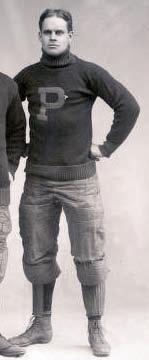Truxtun Hare
| athletics | ||
| silver | 1900 | Pole vault |
Truxtun Hare ( Thomas Truxtun "Trux" Hare ; born October 12, 1878 in Philadelphia , Pennsylvania , † February 2, 1956 in Radnor , Pennsylvania) was an American interdisciplinary athlete who was internationally known as a track and field athlete and medalist at the Olympic Games .
His unusual middle name, which is also published as Truxton in some publications , goes back to the well-known American commodore Thomas Truxtun . The nickname "Trux" is derived from this.
Hare first attended St. Mark's School in Massachusetts before going to study at the University of Pennsylvania . He was an extremely versatile and very socially committed person, was active as a writer, painter and theater artist as well as as a leader of various music and friends circles. In his early years he received various medals and honorary memberships from social associations and lodges .
In addition to his general versatility, Hare had a natural athletic talent. He played for the university team in cricket and American football , most recently as team captain . He was elected to the All American Football team four years in a row . He also tried archery , target shooting and golf . However, he achieved his greatest sporting success in athletics.
As a track and field athlete, he was just as versatile as in the rest of his life. He was active as a runner, jumper and thrower. His strengths, however, lay in the throwing and pushing disciplines. At the Paris Olympics in 1900 , to which the University of Pennsylvania sent its best athletes, he took part in the shot put , discus and hammer throw competitions , but only won a medal in hammer throwing with second place. At the 1904 Olympic Games in St. Louis, Hare was the ideal athlete for the all-round competition, a forerunner of today's decathlon , where he finished third.
Placements at the Olympic Games:
- II. Summer Olympics 1900, Paris
- Hammer throw - silver with 46.25 m (gold to John Flanagan from the USA with 49.73 m; bronze to Josiah McCracken from the USA with 42.46 m)
- Shot put - eighth in 10.92 m (gold to Richard Sheldon from the USA with 14.10 m)
- Discus throw - without a valid distance
- III. 1904 Summer Olympics, St. Louis
Hare was also a member of the US team in the tug of war , which competed against a Scandinavian team consisting of Swedes and Danes . This competition was won, but it turned out that there were a few comrades standing close to them who prevented an impending defeat by intervening in the fight. The fight was viewed as a show fight or private encounter and was not officially rated. Nevertheless, in some publications this fight is equated with winning a gold medal, which is why Hare is often incorrectly referred to as an Olympic champion .
Hare graduated from the University of Pennsylvania as a lawyer . He practiced until 1941 and had mandates at several large companies. Through his work and through his other social and philanthropic commitment, he achieved a very high reputation in his hometown of Philadelphia. He held various offices, including a. he was the chief director of a local hospital as well as a community representative and head of his parish. With his literary skills, he wrote 8 books for young people and was a member of various literary associations. He was represented with paintings and sculptures at numerous exhibitions.
In his old age, he was primarily interested in archery, so it was only natural that he became president of the oldest archery club in the United States, the United Bowmen of Philadelphia. He was inducted into the College Football Hall of Fame five years before his death .
Web links
- Truxtun Hare in the Sports-Reference database (English; archived from the original )
- Hare in the College Football Hall of Fame
| personal data | |
|---|---|
| SURNAME | Hare, Truxtun |
| ALTERNATIVE NAMES | Hare, Thomas Truxtun (full name); Trux (nickname) |
| BRIEF DESCRIPTION | American athlete |
| DATE OF BIRTH | October 12, 1878 |
| PLACE OF BIRTH | Philadelphia |
| DATE OF DEATH | 2nd February 1956 |
| Place of death | Radnor |
